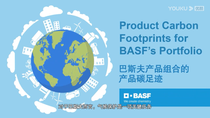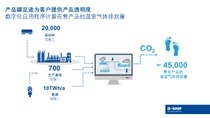可持续发展
产品碳足迹
一个产品在其生命周期内排放多少温室气体?过去几年间,这个问题变得愈发重要。“产品碳足迹”可以给出答案。
产品碳足迹统计了一个产品在其生命周期各个阶段产生的所有温室气体排放量。例如,“摇篮到大门”(部分)的产品碳足迹,指的是从资源开采、前体制造、成品制造,到成品离开公司大门过程产生的碳排放。而“摇篮到坟墓”的产品碳足迹覆盖一个产品的完整生命周期,包括产品使用阶段和其报废后产生的碳排放。
在巴斯夫不断努力争取在2050年前实现二氧化碳净零排放的同时,越来越多的客户在采购决策时将环保纳入考量之中。因此,巴斯夫开发了一套数字化解决方案,用来计算其 45,000 款在售产品“摇篮到大门”的碳足迹。巴斯夫将提供所有全球在售产品的碳足迹数据。因此,客户也将获得有价值的信息,知悉采用巴斯夫的材料将为其业务活动和成品带来多少碳排放量。
巴斯夫产品碳足迹的计算基于其自身生产装置的温室气体排放量,以及所采购的原材料和能源的高质量平均数据。一旦供应商能提供我们所采购原材料的具体碳排放数据,巴斯夫将逐步替代这些平均数据。

减少产品碳足迹的另一选择
产品碳足迹为客户提供了避免温室气体排放的宝贵信息。目前,我们已经通过使用可替代原材料为客户创造附加值,从而帮助客户减少其产品的碳足迹。
例如,巴斯夫的生物质平衡方案,将有机废料与植物油中提炼出的可再生原材料,代替化石燃料,用于一体化生产体系,并精准分配至相应的在售产品中。物质平衡方案的另一应用案例是巴斯夫的“化学循环”(ChemCycling™)项目。2020 年,巴斯夫为客户提供了在生产初始阶段使用“化学回收”废塑料所得原材料而制成的首批商品。与纯化石原材料生产的产品相比,巴斯夫使用这两种方法制得的商品性能相同,但更低碳。
- 了解更多关于生物质平衡 (英文)的信息
- 了解更多关于 “化学循环”(ChemCyclingTM)项目的信息
推动国际标准和规则的确立
巴斯夫产品碳足迹的计算遵循产品生命周期评估(ISO 14044)、产品碳足迹(ISO 14067)的通用标准和《温室气体协议产品标准》。
然而,这些标准没有具体规定如何准确计算每一个产品的碳足迹。在缺乏此类标准的情况下,由不同公司制造的相同产品,其碳足迹还不能直接进行比较。为了创造公平的竞争环境,巴斯夫致力于在化工行业推出基于产品的碳足迹计算指南,创造业内公平竞争环境,使对比产品碳足迹成为可能。
如何进行更全面的可持续发展评估
产品碳足迹使产品的温室气体排放量变得透明。同时,这只是我们更为宏大的可持续发展图景的组成部分。我们采用环境、经济和社会标准对产品进行全面的可持续发展评估。如果您希望有更全面的了解,我们建议您使用多标准评估工具,例如我们的生态效益分析(英文)。
